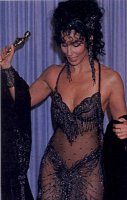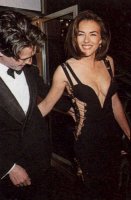| Searching for that mythical item of clothing that enables you to glide from office to party at the
flick of an accessory? Look no further than the old cliché, the little black dress. Not just about subtle understatement, the little black dress can be the sartorial equivalent of a box of
dynamite. Black has dark qualities that hint of sex and power. For centuries it has been symbolic of darkness,
menace and death. In heraldry it signifies grief and penitence. Yet it is a paradoxical colour, worn by
prostitutes and priests alike. To the puritans it was symbolic of piety and sobriety. No other colour has such a
chameleon like qualities.
Gabrielle (Coco) Chanel gave us the little black dress in the 1920's. Her lifelong inspiration was her dislike of
frippery and ostentation. The motivation for her designs remained the same throughout her life “Nothing
makes a woman look older than obvious expensiveness, ornateness, complication, I still dress like I always
did, like a schoolgirl”. The simplicity of her clothes was in tune with the times. Women were becoming more
independent and class barriers were eroding. Chanel's relaxed, unrestricting styles were enthusiastically
embraced. For the fashionable elite, black had been exclusively the colour of mourning. Maids and waitresses
wore black. Chanel took these clothes off the street and redefined them as fashion. Fashion writer Lucie
Francois observed that “It gave women great pleasure to play at looking poor without having to be any the
less elegant”. A friend quipped that Chanel made the whole world wear mourning. American Vogue
described one of her chic black dresses as “A Ford signed Chanel”.
The little black dress may have become something of a cliché but it will be remembered as one of this
century's most enduring fashions. Pioneered by Chanel, successive designers have developed and
experimented with the concept of creating a perfect, simple dress from a single line. Hubert de Givenchy and
Cristobal Balenciaga both shared this idea. Successive designers have gone on to put their own spin on the
concept of elegant simplicity. Azzedine Alaia (dubbed the `King of Cling') gave it a curvaceous, body hugging
twist in the 1980's, providing the inspiration for stretch minis and body hugging Lycra. Gianni Versace was a
master in the art of the little black dress, although his earlier biker styles and bondage dresses substitute sex
appeal for any vestige of sophistication.
The concept of the little back dress is very much in tune with this decade's trend towards minimalism, with the
emphasis on clean lines and simple shapes. The absence of colour, through the choice of black, is indicative
of subtlety and restraint.
Black has been the persuasive colour trend in fashion for almost two decades. Although unflattering to many
complexions, it has many advantages. It is dramatic. Sophisticated. It is slimming. Unlike true colours, which
have a myriad of hues and tones, black is easy to wear: even the colour blind can't go too wrong. It's erotic
association give the wearer a certain frisson. It has long been associated with power, particularly male
authority, and it's adoption by modern woman reflects the shift in the balance of power, with women taking
over traditionally male roles.
Some black dresses have made an indelible impression. They have not only made headlines but have lingered
in the memory, garnering the little black dress almost iconic status. Anita Ekberg dancing in the Trevi fountain
in La Dolce Vita. Rita Hayworth peeling off her long black gloves in Gilda. Audrey Hepburn as Holly
Golightly in Breakfast at Tiffany's. Marilyn Monroe in Some Like it Hot. Cher accepting the 1988 Best
Actress Oscar in a barely there Bob Mackie ensemble. Paula Yates displaying her silconised décolleté at the
funeral of Michael Huthchence. Who can forget Elizabeth Hurley stealing the show at the U.K. premiere of
Four Weddings and a Funeral in a Versace bondage dress? Princess Diana not only won sympathy but also a
massive PR coup by stepping out in a stunning black dress on the night that prince Charles admitted adultery
on television.
The idea of a simple and elegant little black dress has remained a totem of style and fashion since it's
inception by Chanel. Different designers and trends have given it a new twist but the underlying concept
remains remarkably true. Classic black dresses like the shift dress; cheongsam and strapless sheath have
always retained a style and popularity beyond the vagaries of fashion.
This year's black dresses tend to be long than little. Luxurious fabrics, bias cutting, and embroidery provide
opulence and a touch of 1930's Hollywood glamour. Narrow columns of liquid satin skim the figure and
sweep the ankles. Shoe string straps and sleeveless slash neck styles emphasise the neck and shoulders.
Beads and sequins add weight and movement to sheer fabric and evoke the roaring twenties.
For medieval babes, there are the Gothic dresses inspired by Versace, Alexander McQueen and Hussein
Chalayan. These styles are more austere but no less dramatic. Be inspired by Morticia from the Addam's
family!
Add a jet beaded bag, black feather boa or luxurious wrap for the finishing touches or to transform an old
favourite into a contemporary fashion statement.
It's time to pile on the glamour and turn on that old black magic.
| 

![]()





![]()